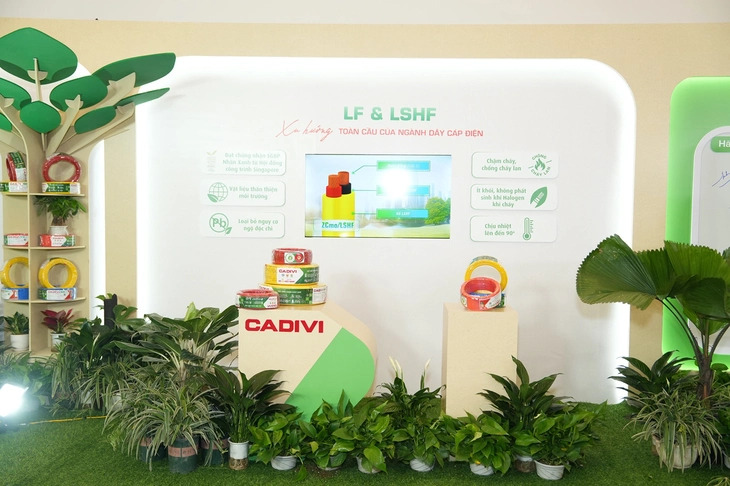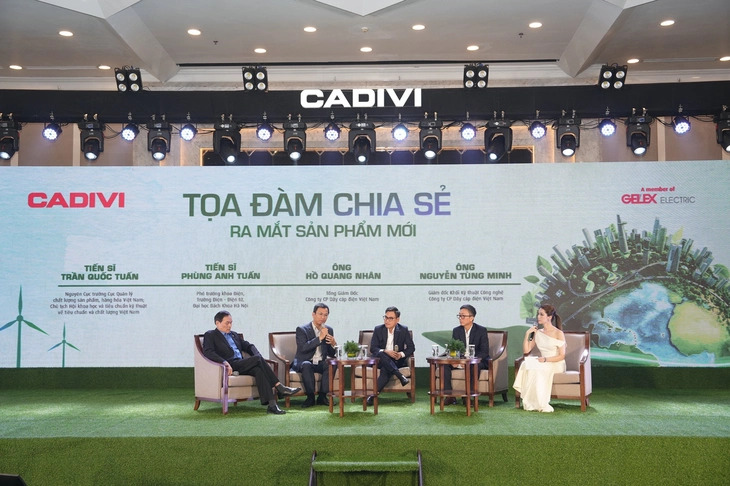Vietnam Electric Cable Corporation (CADIVI), a leading brand in the country's electrical wire and cable market, has officially launched a new range of environmentally friendly electrical cables.
Featuring lead-free (LF) insulation and low-smoke halogen-free (LSHF) materials, these innovative products reinforce CADIVI’s commitment to sustainability and safety.
By leveraging advanced technology and extensive research, CADIVI aims to reduce environmental pollution while enhancing user safety.
The newly launched LF and LSHF cables are designed to minimize toxic smoke emissions in the event of a fire, providing an added layer of protection for individuals and communities.
“This launch represents a significant step forward in promoting electrical safety and protecting our living environment,” said Ho Quang Nhan, CEO of CADIVI.
“Our eco-conscious products are ideal for sustainable construction projects as they prioritize durability, safety, energy efficiency, and resource conservation – key elements in modern green building development.”
For years, CADIVI has focused on research and innovation, continuously integrating state-of-the-art technology into its product lineup.
This commitment not only strengthens its competitive edge but also aligns with Vietnam’s broader transition to a green economy.
“The shift toward sustainability isn’t just a global trend; it’s a core business strategy,” Nhan noted.
He emphasized the importance of businesses taking proactive steps to adopt low-emission technologies, including solar energy, natural ventilation systems, and sustainable materials.
While Vietnam has introduced support mechanisms such as LEED and EDGE certifications to encourage green development, companies must take the lead in implementing these sustainable solutions.
CADIVI actively promotes the use of non-toxic materials and modern production techniques to minimize environmental impact.
The company has also invested in rooftop solar power systems at its manufacturing facilities and continues to optimize production processes to reduce material waste and improve operational efficiency.
“We are not only contributing to the development of green buildings but also playing a direct role in Vietnam’s goal of achieving net-zero emissions by 2050,” Nhan affirmed.
As a subsidiary of Gelex Electric JSC under Gelex Group, CADIVI benefits from a broader corporate strategy that prioritizes research and development (R&D) to drive sustainable product innovation and international technology collaborations.
Nguyen Trong Hien, chairman of Gelex Group, highlighted that the company encourages its subsidiaries to allocate up to two percent of their annual revenue to R&D, reinforcing its commitment to high-quality human resources and technological advancement.
Industry leaders advocate for green transition
Across industries, businesses are ramping up investments in green products to mitigate greenhouse gas emissions.
Dr. Tran Quoc Tuan, chairman of the Vietnam Association for Standards and Quality, emphasized Vietnam’s pledge to achieve net-zero emissions by 2050, as declared at COP26 in Glasgow in 2021.
He underscored that while government policies play a role, enterprises must invest in green technologies, use eco-friendly materials, implement energy-efficient production models, and reduce carbon emissions throughout their operations.
 |
| An experience zone showcases LF and LSHF electrical cables at CADIVI’s new product launch. |
However, Dr. Tuan stressed that environmental considerations must be seamlessly integrated with product quality.
From design to raw material selection, manufacturing, storage, transportation, and consumption, every stage of the product lifecycle should be optimized to maximize resource efficiency and minimize environmental impact.
Echoing these sentiments, CEO Nhan reiterated that the shift toward sustainability is not just an option but a strategic imperative for businesses worldwide.
He emphasized that achieving net-zero emissions requires a holistic approach, combining smart design, renewable energy adoption, sustainable materials, and efficient management systems.
While certifications like LEED and EDGE provide valuable incentives, Nhan pointed out that businesses must take the lead in investing in green technologies.
He cited CADIVI’s efforts in deploying solar energy, optimizing production efficiency, and utilizing low-carbon materials as key examples of its sustainability-driven approach.
“We are dedicated to using non-toxic materials and implementing advanced manufacturing techniques to reduce emissions,” Nhan concluded.
“Our investments in energy-saving solutions, such as rooftop solar systems, further demonstrate our commitment to sustainability.”
Through these efforts, CADIVI is not only supporting the construction of green buildings but also actively contributing to Vietnam’s long-term goal of carbon neutrality by 2050.
Like us on Facebook or follow us on Twitter to get the latest news about Vietnam!

















































